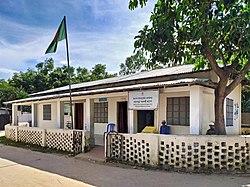Nayapara refugee camp
Nayapara refugee camp
নয়াপাড়া শরণার্থী শিবির | |
|---|---|
 Camp in Charge office | |
| Coordinates: 20°57′22″N 92°15′05″E / 20.955979°N 92.251312°E | |
| Country | |
| Division | Chittagong Division |
| District | Cox's Bazar District |
| Upazila | Teknaf Upazila |
| Population (14 January 2018)[1] | |
| • Total | 23,065 |
The Nayapara refugee camp (Bengali: নয়াপাড়া শরণার্থী শিবির) is a refugee camp in Teknaf, Cox's Bazar, Bangladesh. It is located next to the village of Dhumdumia and is inhabited mostly by Rohingya people that have fled from religious persecution in the neighboring country Myanmar.[2] It is one of two government-run refugee camps in Cox's Bazar, the other being the larger Kutupalong refugee camp.[3] The two refugee camps had a combined population of around 30,000 refugees in July 2017.[4] In September 2017, the United Nations High Commissioner for Refugees (UNHCR) estimated that the combined population of the two refugee camps had increased to over 77,000.[5] As of 14 January 2018, the estimated population of Nayapara refugee camp is around 23,065.[1]
On January 14, 2021, a fire in the camp destroyed around 550 shelters, 150 shops, and a community center, resulting in a loss of homes and belongings for 3,500 Rohingya refugees.[6] The UN World Food Programme, Inter Sector Coordination Group, and Bangladesh Red Crescent were among the organizations offering assistance.[7]
References
- ^ a b "How Aung San Suu Kyi sees the Rohingya crisis". BBC News. 2018-01-25. Retrieved 2022-10-10.
- ^ "The young and the hopeless in Bangladesh's camps". UNHCR. United Nations High Commissioner for Refugees. Retrieved 2 September 2017.
- ^ "Stories from the Rohingya Camps in Bangladesh". 5 September 2016. Retrieved 14 July 2017.
- ^ "Two camps of thought on helping Rohingya in Bangladesh". UNHCR. United Nations High Commissioner for Refugees. Retrieved 14 July 2017.
- ^ Judah, Jacob (15 September 2017). "Rohingya influx strains camp resources in Bangladesh". UNHCR. United Nations High Commissioner for Refugees. Retrieved 4 October 2017.
- ^ McPherson, Poppy Elena; Paul, Ruma (January 14, 2021). Cameron-Moore, Simon (ed.). "Fire destroys homes of thousands in Rohingya refugee camps - UNHCR". Reuters.
- ^ "UN steps up support for thousands left homeless after fire at Rohingya refugee camp". UN News. 2021-01-15. Retrieved 2022-10-10.

